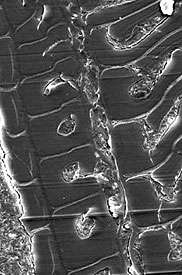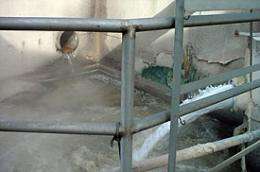INL scientists help harness bacteria power to brew eco-friendly plastic from waste

Three samples of premium wood-plastic composite lumber sit in a stack on a shelf in David Thompson's office at Idaho National Laboratory. The dense, fine-grained boards are uniformly colored in shades that range from light to dark brown.
All three boards match each other in strength and durability. But one of the boards has two special ingredients: plastic made by bacteria, and the same harmless bacteria that made the plastic — by eating wastewater.
Eat more food than you can use, and your body will stockpile the surplus in all sorts of curvaceous and unsightly ways. Many species of bacteria do something similar.
"Plastic, to these bacteria, is like fat," says Thompson, an INL biochemical engineer. Given an abundance of sugars, alcohols or other simple carbon sources, the bacteria will ferment the molecules for energy and string together the leftovers into long chains, or polymers, that they can stash for use in leaner times. Many of these polymers are actually types of plastic called polyhydroxyalkanoates, or PHA for short.
What bacteria make, they can also break down. All three of the sample composite boards in Thompson's office are too dense to absorb much water, which helps them resist rotting and cracking better than natural wood. But if you chipped up Thompson's bacteria-PHA composite board and buried it in an active compost pile, it would biodegrade completely in three to six months. In contrast, the petroleum-based plastics in standard wood-plastic composites could sit in your backyard or in a landfill for hundreds of years or more before breaking down completely.
'This stuff is compost waiting to be'
Professor Michael Wolcott and his students and colleagues at Washington State University figured out how to incorporate the bacterial cells into the wood-PHA composite material. The WSU team made decking material to test the composite's physical and biological properties, but the material can be re-formulated and molded into other products with different amounts of durability and strength.
Wolcott says the material could be ideal for outdoor applications with an expiration date a season or a year down the line: golf tees, for example, or the soil stability mats that help prevent erosion along new highways until new plants take over the barren soil. The stakes that anchor the mats have to be removed after a few months. But stakes made of biodegradable composite could be left in place.
"You can lower the overall energy of construction by not having to do all this takedown work," Wolcott says. An added bonus: as it breaks down, the composite fertilizes the surrounding soil. "This stuff is compost waiting to be," says Wolcott, who also directs WSU's Institute for Sustainable Design.
Using bacteria to make biodegradable plastics isn't a new idea. But producing PHA from bacteria on an industrial scale is normally a costly undertaking, in both dollars and environmental impact. In a 1999 paper in the journal Nature Biotechnology, Dartmouth College bioengineering professor Tillman Gerngross calculated that bacterial plastics cost four to 10 times as much to produce as petroleum plastics and required more water and energy. Gerngross based his figures on the production of purified plastics using a pristine culture of special bacteria-fed refined sugars.

Wolcott and his colleague Frank Loge didn't think bacterial plastic production had to be that fussy or expensive. They teamed with Thompson to develop a more efficient way to make useful products with bacterial plastic. The team partnered with ECO:LOGIC, the Strandex Corporation, and Glatfelter paper corporation, and landed funding from the National Science Foundation and the Department of Energy's Forest Products Industries of the Future program. They drew on their combined expertise in microbiology, materials science, chemistry and engineering. And they came up with a cheap, energy-efficient way to make bacteria turn one man's waste into another man's decking.
'We're making plastic with bugs in sewers.'
Manufacturing petroleum plastics requires a hefty input of fossil fuels and releases significant amounts of air pollution and greenhouse gases. But industrial bioplastic production isn't necessarily any friendlier to the environment. Large amounts of petroleum-based fertilizers, herbicides, insecticides and water go into growing corn and refining sugar from it to feed the bacteria. Even more electricity, solvents and water go into purifying the plastic from the bacterial stew that produces it.
Loge and Wolcott figured they could cut as much as 80 percent of the PHA production cost using two shortcuts. First, they would fatten the bacteria on free wastewater instead of expensive refined sugar. Second, if they could develop a way to incorporate the bacterial cells along with the plastic into the finished composite material, they could skip the many costly steps required to strip the bacterial cells away from the plastic stored inside them.
To test their idea, the researchers tapped into municipal and industrial wastewater streams. Generating usable plastic by feeding the wastewater to bacteria could help clean the water and offset some of the cost of wastewater treatment. What's more, if sewer bug plastic became popular, it could rack up impressive energy savings. The research team calculated that if composites made with unrefined bacteria plastic replaced half of all wood-plastic composite building material by 2020, the building industry could save the energy equivalent of more than 2 million tons of coal per year. And it could prevent the release of several hundred tons of air pollution each year from petroleum plastic manufacturers.
‘The ones that can eat it, will.'
Loge and Thompson set out to coax as much plastic as possible from bacteria and waste. Loge, now an environmental engineering professor at the University of California, Davis, sent two of his graduate students, Greg Mockos and Hsin-Ying Liu, to INL to work with Thompson and INL microbiologist William Smith.
The INL team had no trouble finding the right bacteria for the job. Microbes, it seems, are suckers for free food.
"If you just create the right conditions, the bacteria will come," Loge says. "And there's an awful lot of them that can come." Scientists know of more than 300 species of bacteria that can make PHA. Perhaps several thousand more such species have yet to be identified, Loge says. So the odds are good that a wastewater stream will contain at least one naturally occurring bacterial species that can eat the waste and make PHA.
Indeed, Thompson, Loge and their colleagues have made PHA using bacteria and waste from a brewery in California, a municipal wastewater treatment plant in Idaho, and a pulp-and-paper mill in Ohio. The INL team found that it could increase the plastic yield by subjecting the bacteria to the equivalent of a yo-yo diet. "Give 'em anything they want, then give 'em nothing," Thompson says, and the bacteria will respond by making more plastic, just as humans respond to periodic famine by fattening themselves in times of plenty.
Once the bacteria packed on enough plastic pounds to nearly double their weight, the researchers killed the bacteria, dried the whole mess, and sent it to Washington State University to be mixed with sawdust and molded into composite boards. Wolcott's WSU team tried several recipes and molding processes before it hit upon a method that produced a board with about the same mechanical properties as the boards the team made with petroleum-based and refined bacterial plastics.
Standard wood-plastic composite boards are about half sawdust and half plastic, but Wolcott's board contained nearly equal proportions of sawdust, bacterial PHA and dried bacteria. Under the heat and pressure of processing, the same fats and proteins that had been the building blocks of the bacterial cells became building material of another sort.
Turning bacteria into building material is the real technological coup of the waste-to-plastic project, says Smith. But, he and Thompson add, there's still room for improvement as far as optimizing the fermentation conditions to make more plastic over time.
The research team filed a report in March 2010 that describes what it has learned so far. The team is seeking sponsors for a larger test run and to help commercialize the process. The researchers hope that the building industry will catch onto something composters already know: that frugality, ingenuity and the right bacteria can turn trash into something quite valuable.
Provided by Idaho National Laboratory


















